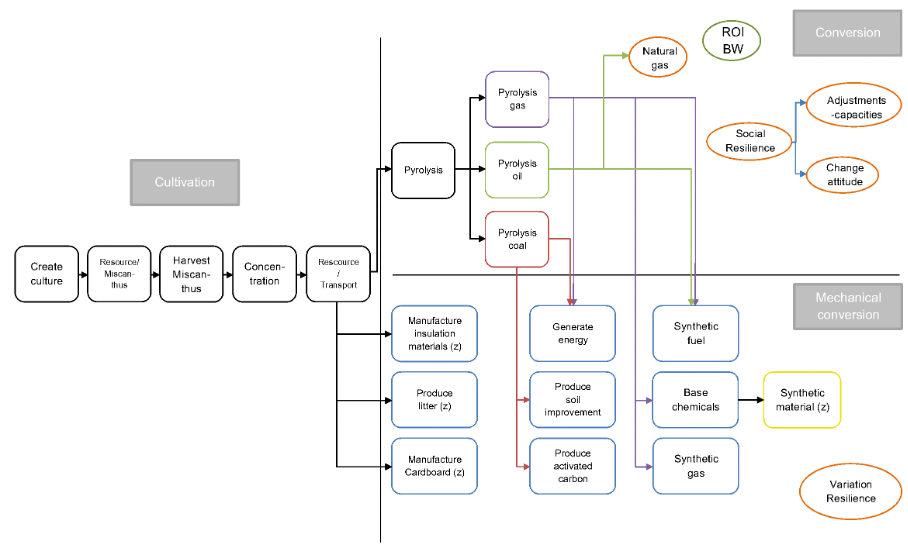Simulation of Miscanthus- and Sorghum-based resilient value chains in the Danube Region
Can the value chains in the Danube macro-region be more sustainable and resilient against disruptions such as pandemics? How modelling could help to simulate the economic viability of developing Miscanthus and Sorghum based value chains in that region?
The project Danube Alliance, a flagship project of the Priority Area 8 of the EU Strategy for the Danube Region (EUSDR), aimed to promote resilience of existing or new transnational supply chains in that territory. Supporting SMEs so they could be embedded in new value chains was at the core of the activities. The project was implemented from January 2020 till December 2022 by VDI/VDE Innovation and Technik GmbH as lead partner together with BIOPRO Baden-Württemberg GmbH, Herman Hollerith Zentrum (HHZ) of the Reutlingen University, and Steinbeis Europa Zentrum.
The first phase of the project (2021 – 2022) was established on four steps:
- Analysis of selected value chains
- Simulation through models
- Knowledge transfer
- Awareness-raising
The partnership pre-defined a “value network” as a value chain that can be “resilient” and “adaptable” in times of crisis, as well as “resource-efficient and circular”. These components defined the “New Resilience” criteria that guided the analysis, modelling and development of value chains through the project.
Based on this criterion, the partnership discussed with experts in Baden-Württemberg and beyond to identify business cases that could disclose promising scenarios of bio-based value chains across the Danube. In this vein, miscanthus (Elefant grass) and sorghum cases were chosen and modelling was developed to know which products and services could be delivered from both grass crops, ranging from bioenergy and biofuels to the production of bio-based basic chemicals via a cascade use. Both grasses are highly adaptable in terms of location, temperature and water availability, what makes them climate-resilient and useful for marginal lands. Thus, conflicts of land use can be avoided.
BIOPRO participated actively in the process of selection of the value chains and provided technical advice, together with experts from Baden-Württemberg such as Advanced Ecologics GmbH and the Botanical Institute at the Karlsruhe Institute of Technology (KIT).
The Miscanthus Case
The key stages of cultivation, harvesting, transportation and conversion of miscanthus were described. A model was drawn by HHZ showing different applications of parts of the grass depending on the conversion type (pyrolytic, mechanical) and the application of the final product (insulation material, cardboard, pyrolysis gas, oil, fuels, basic chemicals, and biochar). Corn straw was also considered in the miscanthus value network.
After a detailed presentation of all relevant process steps, price-quantity frameworks were integrated into the process model using different input data (e.g. cultivation areas, harvesting times, weather data, operational and purchase costs, energy consumption). The model foresaw the energy and fuel use as well as material recovery of the grass. A pilot region in Vidin (Bulgaria) was identified and a trip from 14 to 16 September 2022 was organised on this purpose. One of the outputs was that the main challenge in the development of this value network lies primarily in the financing of the power plant installation for biomass conversion. A potential territorial implementation strategy and discussions on the business case were produced during the last part of the project.
 Key stages of the Miscanthus value network.
© Fauser & Hertweck, HHZ
Key stages of the Miscanthus value network.
© Fauser & Hertweck, HHZ
The Sorghum Case
The scope of applications of sorghum in Europe until 2022 were much reduced. Its uses for human consumption, animal feed and bioethanol production are well reviewed to date, while other applications (e.g. biopackaging, biofertiliser) show rather low Technology Readiness Levels (TRLs). On the one hand, a model was created for sorghum as an energy crop and, on the other hand, for use as food and feed. The costs were mostly related to the crop quantity, which results from the field size and the harvest amount per hectare.
To facilitate and develop resilient value chain projects, collaborations with partners from the Danube Region were built up. Several meetings were held with the Hungarian packaging technology cluster Omnipack, the Pulp and Paper Institute, Ljubljana (ICP) and Moholy-Nagy University of Art and Design (Budapest), in which packaging applications of sorghum were discussed. However, it was concluded that the TRL was too low. Eventually, a partner with a concrete business case or with more advanced experience in terms of market potential could not be identified.
Impact and learnings
The activities of the project reached around 110 stakeholders across the Danube Region. After two years of project implementation, it was concluded that while the overall Danube Alliance approach can work, a resilient value chain in the sense of a circular bioeconomy is difficult to accomplish in many cases. The outputs reckoned the need for further integrating different digital services (e.g. Value Chain Modeller, Value Chain Generator) for targeted value chain development. The project depicted relevant findings that may be followed-up through new projects in a near future.